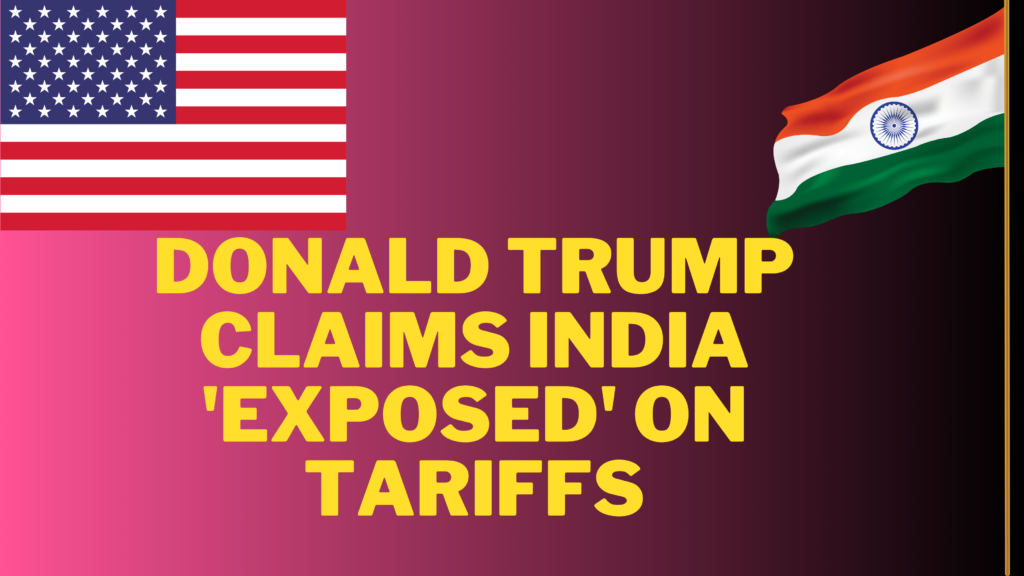Donald Trump Claims India ‘Exposed’ on Tariffs and he has declared that India has consented to reduce tariffs on products imported from the United States, emphasizing that his administration is bringing to light what it perceives as inequitable trade practices. This statement coincides with ongoing negotiations between India and the US for a Bilateral Trade Agreement (BTA), which seeks to dismantle trade barriers and enhance market opportunities for both nations. In a related development, Tesla is advocating for the elimination of import duties as it plans to expand its presence into the Indian market. While the Indian government has yet to officially confirm any tariff adjustments, discussions with US officials remain active and ongoing.
Key points

More info on Why Donald Trump Claims India ‘Exposed’ on Tariffs
Trump claimed that India has been “exposed” and that due to his actions, India has agreed to reduce tariffs on US products. He used aggressive language, stating that India had imposed high tariffs on the US, but now they are being reduced. Trump has a history of imposing and then reducing tariffs on countries like Canada and Mexico. He often uses tariffs as a negotiation tool, but they have caused confusion in the US market.
India-USA trade relations and what is going on at International levels.
India and the US are negotiating a major trade deal. Officials from both countries, including Indian Commerce Minister Piyush Goyal, have been discussing the deal, aiming to finalize it by early April. The deal is expected to benefit both nations. There is a need for India to respond firmly to Trump’s statements. Some analysts believe India should assert itself and not let Trump dominate the narrative, especially since India is a significant market for the US.
The global media, especially Indian media, is closely covering Trump’s statements and the ongoing trade negotiations between India and the US. Trump’s aggressive language and claims have drawn significant attention. India has clarified that it is not interested in de-dollarization or replacing the US dollar in global trade, unlike other BRICS nations. This stance has been seen as a friendly gesture towards the US. India needs to take a stronger stance in its dealings with the US, especially with Trump. Analysts suggest that India should not be overly accommodating and should assert its position more clearly.
India-China Relations— Amidst the US-India trade discussions, China has suggested that India and China should work together. This comes after the US imposed tariffs on China, and China has decided to retaliate with its own tariffs on the US.
WTO and Trade Disputes— India and the US have had trade disputes in the past, particularly during the Biden administration. Both countries have clashed at the World Trade Organization (WTO), but have also worked towards resolving issues.
Tariffs: What they are and why they matter
Tariffs have been a hot topic in trade discussions for years, but what exactly are they, and how do they affect everyday consumers and businesses? Simply put, a tariff is a tax that a government places on imported goods. The idea is to make foreign products more expensive, giving local industries a competitive edge. But the real-world impact is more complicated than it seems.
Governments impose tariffs for different reasons. Some do it to protect homegrown businesses especially new or struggling industries—from cheaper foreign competition. Others use tariffs to punish countries for unfair trade practices, like flooding the market with artificially cheap goods. And in some cases, tariffs are just a way to bring in extra government revenue.
While tariffs can help domestic companies, they often come with downsides. For consumers, higher import taxes mean pricier goods—everything from electronics to clothing. For businesses that rely on imported materials, tariffs can drive up production costs, leading to layoffs or price hikes. And when countries retaliate with their own tariffs, it can spark trade wars that hurt global markets.
The debate over tariffs isn’t black and white. Supporters argue they save jobs and boost local economies, while critics say they stifle competition and hurt consumers. The key is finding a balance protecting domestic industries without triggering unnecessary economic strain. As trade policies continue to evolve, understanding tariffs is crucial for anyone following the global economy.